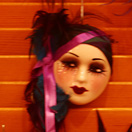
Character
In this project, students learn how a character can be developed. At the end of the project, students perform a brief scene for the characters in their group from a script which they devise.
The aims are to:
- create a three-dimensional character using various stimuli
- discover how to devise a script.
By the end of this project, students are expected to be able to:
- create a realistic character
- produce a basic improvisation about a character
- write and develop a script based around the character and perform it.
The skills covered in this project include (but are not limited to)  hot seating,
hot seating,  prepared improvisation,
prepared improvisation,  role-on-the-wall,
role-on-the-wall,  role play,
role play,  still image and
still image and  thought-tracking.
thought-tracking.
The techniques which are covered in lessons in this project include:
- hot seating
- mime
- performance
- rehearsal
- role-on-the-wall
- script-writing
- still image
- thoughts aloud.
The key words which are used in this project include:
- body language
- facial expression
- freeze frame
- hot seating
- mime
- motivation
- objective
- performance
- rehearsal
- role-on-the-wall
- script
- self-evaluation
- stereotype.
The text which students encounter during this project includes magazine images of people and a script.
This series of lessons has cross-curricular links with English.
Students should be assessed in this project on the extent to which they:
- create a character from a visual stimulus
- develop a character and perform it
- write and develop a short script
- evaluate their own work and that of others, looking in particular at realistic characterisation.
Web sites which could be used for further information on this topic include:
 | Eric Meyer: Resources for Actors: Stanislavski |
|---|
 | Stella Adler Studio of Acting: Biography of Stanislavski |
|---|
 | Konstantin Stanislavski biography |
|---|
This project meets the following recommendations from Drama in Schools (Second Edition) (Arts Council England, 2003). For a complete mapping, see Managing: Drama in Schools.
Level 3: Performing
- Act out improvised dramas and existing scripts, creating characters that are clearly different from themselves, and experiment with voice, gesture, costumes and staging
Level 3: Responding
- Both in and out of role, comment thoughtfully on the drama and suggest ways of improving it
Level 4: Making
- Establish a character, with control over movement and voice
Level 4: Performing
- Experiment with their voices and movement, to create or present different characters in performance
A printable version of the project is provided here:
A summary of the project is provided here:








 Aims
Aims Character
Character